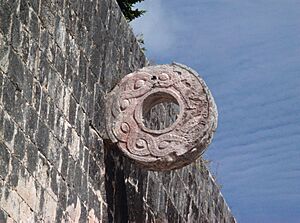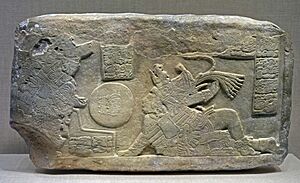Mesoamerican rubber balls facts for kids
Ancient Mesoamericans were the first people to create rubber balls over 3,600 years ago, around 1600 BCE. They used these balls in many ways. For example, the Mesoamerican ball game used different sizes of solid rubber balls. People also burned rubber balls as offerings in temples, buried them in special deposits, and placed them in sacred bogs and cenotes (natural sinkholes).
Contents
How Ancient Rubber Was Made
Ancient rubber came from the sap, or latex, of the rubber tree (Castilla elastica). This tree grows naturally in the warm, tropical areas of southern Mexico and Central America. To turn the sticky latex into bouncy rubber, people mixed it with the juice of a plant called Ipomoea alba, which is a type of morning glory. This process was discovered thousands of years before Charles Goodyear invented modern vulcanization. Once the rubber was made, it was shaped into strips and wrapped around a solid rubber core to build the balls.
Early Discoveries of Rubber
Archaeologists have found proof that rubber was used very early in Mesoamerica. About a dozen rubber balls were found in a sacred bog called El Manati in the Olmec region. These balls date back to about 1600 BCE. By the time the Spanish arrived in the Americas, about 3,000 years later, rubber was being sent from tropical areas to many different places across Mesoamerica.
Rubber was used for many things, but rubber balls for games and offerings were the most important. To the Aztecs and the Maya, the rubber latex flowing from the tree was like blood. Rubber was a symbol of new life and growth. It was often burned, buried, or placed in sacred pools as a gift to their gods.
Sizes and Weights of Ballgame Balls
We don't know the exact sizes or weights of the balls used in the ancient ballgame. The size varied depending on the version of the game played, such as hip-ball, handball, or stick-ball. Even within the same game, sizes could be different. For example, Late Classic hip-ball courts had
with different-sized holes. This suggests that the balls themselves were not all the same size.
Most of the ancient rubber balls found by archaeologists were placed as offerings. There's no proof that these specific balls were used in actual games. In fact, some were made just to be offerings. However, ancient pictures and modern versions of the game can give us clues. For example, archaeologist Laura Filloy Nadal compared the sizes of modern ballgame balls:
| Ballgame Version | How the Ball Was Struck | Ball Diameter | Ball Weight |
|---|---|---|---|
| Ulama de cadera | Hip | Smaller than 20 cm (8 in) | 3–4 kg (6.5–9 lbs) |
| Ulama de mazo | Heavy bat (5–7 kg) | Not available | 500–600 g (18–21 oz) |
| Ulama de brazo | Forearm | About 11 cm (4.5 in) | Smaller than 500 g (16–18 oz) |
| Pelota mixteca | Heavy glove | 8–10 cm (3–4 in) | 170–280 g (6–10 oz) |
Most researchers believe that the ancient hip-ball was about the size of a volleyball. However, it was much heavier, weighing 3 to 4 kg (6.5–9 lbs), which is about 15 times heavier than an air-filled volleyball. The ancient handball or stick-ball was probably a bit larger and heavier than a modern baseball.
Only about 100 ancient rubber objects have been found. All of them were discovered in still, freshwater places. These sites include El Manati, the Sacred Cenote at Chichen Itza, and the ruins of Tenochtitlan.
Here's a summary of some ancient balls that have been found:
| Location | Culture | Number Found | Ball Diameter | Time Period |
|---|---|---|---|---|
| El Manati | Olmec | 5 | 10–14 cm | 1600–1700 BCE |
| El Manati | Olmec | 2 | 22 cm | 1200 BCE |
| Sacred Cenote | Maya | Unknown | 4 cm | 850 - 1550 CE |
| Main ballcourt, Tenochtitlan | Aztec | 2 | 7 cm | Early 16th century? |
| House of Eagles, Tenochtitlan | Aztec | 4 | 6-8.5 cm | Early 16th century? |
Giant Balls and Symbolic Meanings
Some ancient pictures show balls that look very large, or even appear to have skulls or people inside them. While there's no physical evidence of such balls, these images have led to much discussion.
Many images of ballplayers show balls that seem huge, perhaps 1 meter (over 3 feet) across or more. These pictures include the one shown here, as well as images on the "Dallas vase" and other ancient artworks. Most researchers think these images are exaggerations. A solid rubber ball 1 meter wide would be incredibly heavy, weighing almost 500 kg (over 1,000 lbs), making it nearly impossible to move.
Some experts suggest these large balls are symbolic. They might represent important myths or stories. For example, it's thought that heavily dressed nobles might have taken easy shots at an oversized ball to re-enact a creation story.
Marc Zender from the Peabody Museum of Archaeology and Ethnology has studied a common ball-glyph (symbol) seen on balls, like the one in the image. He believes it means "handspan," which is about 21.5 cm (8.5 in) in circumference. When combined with other numbers, Zender thinks that Classic Maya ballgame balls could have been from about 62 to 96 cm (2 to 3 feet) in diameter.
Images of skulls on balls, found at the Great Ballcourt at Chichen Itza and on other Maya artifacts, have led some researchers to wonder if the skulls of sacrificed people were wrapped in rubber to make hollow balls. However, besides these images, there is no other evidence to support this idea.
On Altar 8 at Tikal and on the Hieroglyphic Stairs at Yaxchilan, captives appear to be inside or on top of balls. Like the giant and skull-balls, most researchers don't believe these images are meant to be taken literally. Instead, they suggest the captive is "bound and tied up in the shape of a ball."



